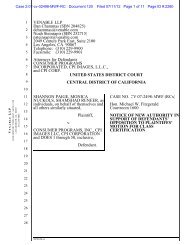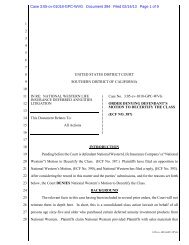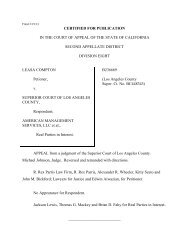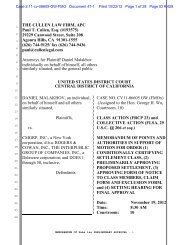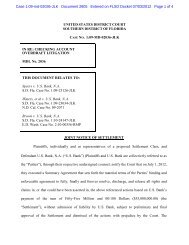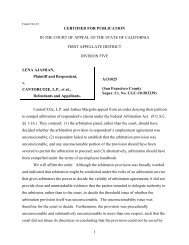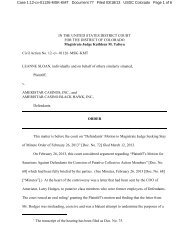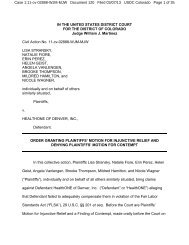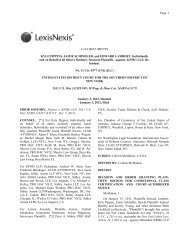here - FindLaw
here - FindLaw
here - FindLaw
Create successful ePaper yourself
Turn your PDF publications into a flip-book with our unique Google optimized e-Paper software.
B. Choice of Law<br />
Section 16 of the Agreement provides: ―This Agreement shall be construed,<br />
governed by, and enforced in accordance with the laws of the State of Texas (except<br />
w<strong>here</strong> specifically stated otherwise <strong>here</strong>in), except that for claims or defenses arising<br />
under federal law, the arbitrator shall follow the substantive law as set forth by the United<br />
States Supreme Court and the United States Court of Appeals for the Fifth Circuit. The<br />
arbitrator does not have the authority to enlarge, add to, subtract from, disregard, or . . .<br />
otherwise alter the parties‘ rights under such laws, except to the extent set forth <strong>here</strong>in.<br />
The parties recognize that the Company operates in many states in interstate commerce.<br />
T<strong>here</strong>fore, it is acknowledged and agreed that the Federal Arbitration Act, 9 U.S.C. § 1,<br />
et seq., shall govern this Agreement and the arbitration.‖ (Italics added, boldface<br />
omitted.)<br />
―The phrase ‗governed by‘ is a broad one signifying a relationship of absolute<br />
direction, control, and restraint. . . . [T]he [choice-of-law] clause reflects the parties‘ clear<br />
contemplation that ‗the agreement‘ is to be completely and absolutely controlled by<br />
[Texas] law [and the FAA].‖ (Nedlloyd, supra, 3 Cal.4th at p. 469.) Because this case<br />
does not involve any federal claims or defenses, decisions of the United States Supreme<br />
Court and the Fifth Circuit are not binding as to the substantive law governing Peleg‘s<br />
causes of action. In any event, the substantive law, whatever it may be, is not relevant<br />
<strong>here</strong>.<br />
In assessing the validity of a choice-of-law clause, ―the proper approach . . . is for<br />
the court first to determine either: (1) whether the chosen state has a substantial<br />
relationship to the parties or their transaction, or (2) whether t<strong>here</strong> is any other reasonable<br />
basis for the parties‘ choice of law. If neither of these tests is met, that is the end of the<br />
inquiry, and the court need not enforce the parties‘ choice of law. If, however, either test<br />
is met, the court must next determine whether the chosen state‘s law is contrary to a<br />
fundamental policy of California. If t<strong>here</strong> is no such conflict, the court shall enforce the<br />
parties‘ choice of law. If, however, t<strong>here</strong> is a fundamental conflict with California law,<br />
18



